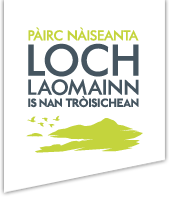
James Stuart shares his thoughts on his eight years on the Board
James Stuart served eight years on the National Park Authority Board, stepping down as Convener in February after the maximum two terms.
He shares his thoughts on the highlights and challenges during his eight years on the Board:
A walk in the park
On the 1st of March 2017, Loch Lomond and the Trossachs National Park introduced Camping Management Bylaws. It was also my first day as Convener. The role of Convener may not be familiar to everyone, in practice it is similar to being a Chair. I rather like the name as it speaks to the heart of what a National Park is and how it works, our superpower perhaps – we are a convening force that drives change through influence and partnership working.
As I started my tenure, there was less awareness of global emergencies and thoughts of a global pandemic were reserved to a handful of scientists. And yet, as I step back from the role of Convener nearly six years later, these have become our reality and are the issues that have defined my experience as Convener.
21st Century National Parks
“Thousands of tired, nerve-shaken, over civilized people are beginning to find out that going to the mountains is going home; that wildness is a necessity; and that mountain parks and reservations are useful not only as fountains of timber and irrigating rivers, but as fountains of life.” John Muir, Our National Parks (1901).
John Muir’s words, written more than 120 years ago, could have been penned yesterday. Exhausted and stressed people across the world have re-evaluated their relationship with nature, rushed to spend time in green spaces through the dark days of the pandemic and continue now to look to nature for solace, respite and recuperation.
Our relationship with nature was already in the spotlight pre-pandemic after Greta Thunberg and hundreds of thousands of young people across the globe declared that our climate and nature were in crisis and that emergency action was required.
This has led to consideration of the role of our National Parks and what we can do to address these crises. Our role is perhaps more relevant – and more challenging – than it has ever been. It is imperative we rise to that challenge and become Parks fit to meet the challenges of our time: 21st Century National Parks.
People and communities
Nerve-shaken as many of us may have been through the pandemic, what stood out to me as we navigated such tricky waters was the resilience of our team and communities across the National Park. It was awe-inspiring and I will be forever grateful for their work, dedication and compassion through those tough weeks, months and years.
Greta Thunberg observed in her speech to the UN Climate Change Conference in 2018 that, “no one is too small to make a difference” and that is particularly true of the young people who play a part in our work here in the National Park. They are inspirational, articulate and they are determined to push for change. During COP26 for example, our young people played a prominent role, launching a joint statement by National Parks and Protected Areas across the world.
Lightning rod for change
And change – as uncomfortable as it can sometimes be – is what we need. Continuing on our current course is simply not an option.
What is heartening, and gives me considerable hope for our future, is that I have already seen evidence of change and innovation. The National Park Authority is already developing large-scale restoration projects and is piloting new forms of green finance with our UK Partners (National Parks Partnership and Palladium) through Revere.
There are also shifts in thinking across government, environmental organisations and a host of other partners who recognise the potential of National Parks to model the future and to be a lightning rod for change; using these special places to rapidly develop new and sustainable models of working, land-use and finance that meet the needs of a low-carbon, nature positive rural economy.
COP26
The hosting of COP26 on our door step in Glasgow was one of the highlights of my time with the National Park. Our work to make the most of this focus on Scotland led to the development of an International Protected and Conserved Areas Joint Statement. Together we established the role of 21st Century National Parks as a focal point for action on climate and nature and a key space in which people can connect with these crises.
We also strengthened relationships with other National Parks across the UK, Europe and the world and this collaboration continued through to COP15 last year.
New National Parks
Following the Bute House agreement, Scotland has taken an active role in exploring the role of National Parks and is committed to designating at least one new National Park this parliamentary term. Our work in Loch Lomond & The Trossachs National Park continues to feed into this discussion and to help shape and inform the future of National Parks in Scotland.
It is a tremendously exciting time and, whilst I am not leaving the National Park family, I am sad to be leaving Loch Lomond. The park is in tremendous hands, with talented and passionate people at every level in the organisation. I expect wonderful things.
John Muir noted in one of his essays that “in every walk with nature one receives far more than he seeks”. Walking in and with the Loch Lomond and the Trossachs National Park has been a defining experience in my life; it has shaped my world view and kindled a passion for the global family of protected areas. I have received more than I could ever have anticipated and I am grateful to all those who have supported and inspired me. Thank you.

